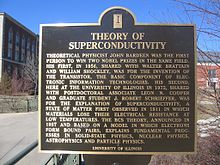John Bardeen

John Bardeen (born May 23, 1908 in Madison , Wisconsin , † January 30, 1991 in Boston ) was an American physicist and two-time Nobel Prize winner in physics . So far, John Bardeen and Frederick Sanger are the only people who have been awarded the Nobel Prize twice in the same discipline.
Life
John Bardeen was born as the son of the anatomy professor Charles R. Bardeen , who was also the dean of the Medical School of the University of Wisconsin in Madison, and the teacher Althea Harmer. His mother died in 1920 when John Bardeen was 12, and his father married Ruth Hames of Milwaukee , Wisconsin. The highly intelligent student, who skipped several grades, began studying electrical engineering , physics and mathematics at the University of Wisconsin at the age of 15 .
Bardeen received a Bachelor of Science in 1928 and a Master of Science in 1929 in electrical engineering . In 1933 he began further studies in physics and mathematics at Princeton University and from 1935 at Harvard . Here he specialized in quantum theory in the field of solid state physics and received his doctorate in mathematical physics in 1936 with a thesis with Eugene Paul Wigner (winner of the 1963 Nobel Prize in Physics).
From 1938 to 1941, Bardeen was an Assistant Professor at the University of Minnesota at Minneapolis . During World War II he worked as a physicist at the US Naval Ordnance Laboratory in Washington, DC
In 1954 Bardeen was elected to the National Academy of Sciences , 1958 to the American Philosophical Society, and 1959 to the American Academy of Arts and Sciences . In 1962 he received the Fritz London Memorial Prize and donated the money from his second Nobel Prize, among other things, to endow this prize.
Bell Labs and the development of the transistor
As a physicist at Bell Telephone Laboratories in Murray Hill ( New Jersey , 1945-1951) he belonged together with the physicists William B. Shockley and Walter Brattain to a working group that deals primarily with the electrical conductivity of semiconductors and metals and the surface properties of these Materials busy. With the help of germanium crystals , they discovered the transistor effect on December 23, 1947 and constructed the first bipolar transistor , a type of transistor that triggered an electronic revolution through the possibilities of miniaturization and made many developments in microelectronics and computer technology possible.
For this discovery, Bardeen and his two colleagues received the Nobel Prize in Physics in 1956 .
Illinois and work in the field of superconductivity
In 1951, Bardeen left Bell Telephone Laboratories and was Professor of Electrical Engineering and Physics at the University of Illinois at Urbana-Champaign until 1975 . Here was his first doctoral student Nick Holonyak (1954), the inventor of the first light-emitting diode in 1962. Bardeen, together with Leon Neil Cooper and John Robert Schrieffer, developed the theory of superconductivity - the disappearance of the electrical resistance of certain metals and alloys at nearby temperatures of the absolute temperature zero . The theory came to be known as the BCS theory , named after the first letters of the discoverers. Bardeen had already researched the phenomenon in the 1930s and came up with a theoretical explanation in the 1950s. In the electrical engineering department, he founded a research program on superconductivity. In the physics department, he also founded a research program on macroscopic quantum systems, in particular on superconductivity and quantum liquids.
In 1972, together with Cooper and Schrieffer, Bardeen received his second Nobel Prize in Physics for his fundamental contribution to the theory of superconductivity . Bardeen was the first scientist to receive the Nobel Prize twice in the same category.
In 1975 he retired; he lived in Urbana, Illinois , until his death .
His sons William Bardeen and James M. Bardeen are also well-known physicists.
literature
- Bernhard Kupfer: Lexicon of Nobel Prize Winners. Patmos, Düsseldorf 2001, ISBN 3-491-72451-1 .
- Peter Neulen: Brockhaus, Nobel Prizes: Chronicle of Outstanding Achievements. Brockhaus, Mannheim et al. 2004, ISBN 3-7653-0492-1 .
- Lillian Hoddeson , Vicki Daitch: True genius. The life and science of John Bardeen. The only winner of two Nobel Prizes in physics. Joseph Henry Press, Washington DC 2002, ISBN 0-309-08408-3 .
Web links
- Information from the Nobel Foundation on the 1956 award ceremony for John Bardeen (English)
- Information from the Nobel Foundation on the awarding of the 1972 award to John Bardeen
Individual evidence
- ↑ Nice Guys Can Finish As Geniuses at the University of Illinois at Urbana-Champaign. . In: Knight Ridder News Service , Chicago Tribune, January 25, 2003. Archived from the original on May 16, 2011. Retrieved August 3, 2007.
- ^ Biography at the University of Illinois at Urbana-Champaign. The University of Illinois at Urbana-Champaign, accessed January 17, 2013 .
| personal data | |
|---|---|
| SURNAME | Bardeen, John |
| BRIEF DESCRIPTION | American physicist and Nobel Prize winner |
| DATE OF BIRTH | May 23, 1908 |
| PLACE OF BIRTH | Madison , Wisconsin , USA |
| DATE OF DEATH | January 30, 1991 |
| Place of death | Boston , USA |

